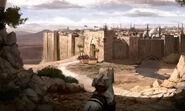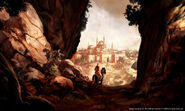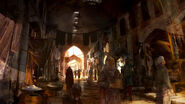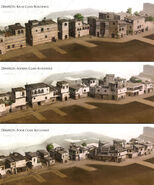No edit summary |
No edit summary |
||
| (48 intermediate revisions by 31 users not shown) | |||
| Line 1: | Line 1: | ||
| − | {{Era| |
+ | {{Era|Locations}} |
{{WP-REAL}} |
{{WP-REAL}} |
||
| − | {{WPlocations}} |
||
{{Location Infobox |
{{Location Infobox |
||
|image = Damascus-depth.jpg |
|image = Damascus-depth.jpg |
||
|factions = [[Templars]] |
|factions = [[Templars]] |
||
| − | |targets = [[Tamir]]<br>[[Abu'l Nuqoud]]<br>[[Jubair al Hakim]] |
+ | |targets = [[Tamir (1190)|Tamir]]<br>[[Alaat]]<br />[[Tamir]]<br />[[Abu'l Nuqoud]]<br />[[Jubair al Hakim]] |
| − | |flags = Saracens flags |
+ | |flags = [[Saracens]] flags |
| − | + | |hideh = yes |
|
| + | |landmark = [[Umayyad Mosque]]<br>[[Citadel of Saladin|Citadel of Damascus]]<br>[[Souk Al-Silaah]]<br>[[Souk Sarouja]]<br>[[Sinan Pasha Mosque]]<br>[[Madrasah Al-Kallāsah]]<br>[[Bab Tuma]]}} |
||
| − | '''Damascus '''(Arabic: دِمَشق, ''Dimashq'') is the capital and largest ancient city of [[Syria]]. During the Second Crusade, around 1148, the city repelled attacks, finally being acquired by [[Salah Al'din]] in the mid 1100s. Salah al'Din granted scholars from far and wide the chance to study in one of the many Madrasahs scattered throughout the city's neighborhoods. Almost unaffected by the war, the city remained an extremely clean and gorgeous site. |
||
| + | '''Damascus''' is the capital and largest ancient city of [[Syria]], believed to have been founded in the third millennium BCE. Damascus is located in the eastern foothills of the {{Wiki|Anti-Lebanon Mountains|Eastern Lebanon Mountain Range}}, near the delta of the [[Barada]] River. |
||
==History== |
==History== |
||
| − | === |
+ | ===High Middle Ages=== |
| + | During the Second Crusade, around 1148, the city repelled multiple attacks until being acquired by [[Saladin|Salah Al'din]] in the year 1174. Upon gaining control of the city, he granted scholars from far and wide the chance to study in one of the many Madrasahs scattered throughout the city's neighborhoods. In between 1190 and 1191, the [[Assassins|Assassin]] [[Altaïr Ibn-La'Ahad]] visited the city numerous times and assassinated a number of prominent Templar figures including Alaat, Tamir, Abu'l Nuqoud and Jubair al Hakim. During that time, it had an approximate population of 45,323. Since the city was virtually unaffected by the war, it remained an extremely clean and gorgeous site.<ref name="ac1">''[[Assassin's Creed]]''</ref> |
||
| − | The [[Assassins|Assassin]] [[Altaïr Ibn-La'Ahad]] visited the city in 1190. His first mission involved interrogating a merchant named [[Misbah]] and assassinating [[Tamir (Altaïr's Chronicles)|Tamir]]. He also made his way to the local circus, where he acquired more information on his current mission of gaining entrance to the [[Temple of the Sand]]. Furthermore, he managed to assassinate a local [[Templar]] member named [[Alaat]], on [[Fajera]]'s request.<ref name="chronicles">''[[Assassin's Creed: Altaïr's Chronicles]]''</ref> |
||
| − | === |
+ | ===18th century=== |
| + | In 1757, [[Haytham Kenway]] journeyed to Damascus to locate his half-sister [[Jennifer Scott|Jenny]], who had been sold into slavery in the {{Wiki|Azm Palace|palace}} of {{Wiki|As'ad Pasha al-Azm}}. Haytham and [[Jim Holden]] disguised themselves as {{Wiki|eunuchs}} to infiltrate the palace. However, while Haytham escaped with Jenny, Holden was captured fending off guards.<ref>''[[Assassin's Creed: Forsaken]]''</ref> |
||
| ⚫ | |||
| + | ==Districts== |
||
| ⚫ | The Middle District contained the [[Sinan Pasha Mosque]] and Formal Gardens |
||
| + | ===Poor district=== |
||
| ⚫ | The Poor District was considered to be a very busy section and constantly packed with citizens. This caused a lot of traffic throughout the streets with many civilians moving about. It was home to the sprawling and very impressive [[Souk Al-Silaah]], which was a major trading point within the city and dominated the surrounding area. Due to its eloquent ceremonial courtyard, situated in the center, the Souk was the site where the Templar and arms dealer Tamir conducted his daily business. Strangely, though, despite Tamir having stationed multiple guards in the nearby corridors, the security around the Souk was rather light. This allowed Altaïr to silently slip in and assassinate Tamir.<ref name="ac1"/> |
||
| + | ===Middle district=== |
||
| − | Almost half the city in terms of size, it was the Rich District that possessed many of the structural landmarks that attracted outsiders to the city. The partially rebuilt [[Citadel of Salah Al'Din]] was a key fortification that demanded planning for a successful infiltration. The most impressive feature of the district, and probably the entire city, were the [[Umayyad Mosque]] and the [[Merchant King's Palace]].<ref name="ac1"/> |
||
| ⚫ | The Middle District contained the [[Sinan Pasha Mosque]] and Formal Gardens. These featured larger east-west thoroughfares connecting the different areas. This section of Damascus included many places of learning, until Jubair al Hakim arrived and began a city quest to destroy all written text. The central feature was Jubair's [[Madrasah Al-Kallāsah|Madrasah]], where he and his scholars burnt all forms of books and scrolls they had taken from the city. When Altaïr traveled there to assassinate Jubair, the security was very high, due to the Assassins' continued success.<ref name="ac1"/> |
||
| + | ===Rich district=== |
||
| − | The interior of the palace was lightly secured, unless one of the Merchant King's lavish parties was in full swing. Traffic around the palace grounds was rather light, given the location. Slightly north was the [[Sarouja Souk]] Market Quarter, where both traffic and security were moderate. Sarouja Souk held the reputation of being the largest market in the Holy Land. It was split into two separate structures that ran from west to east, and north to south.<ref name="ac1"/> |
||
| + | The Rich District stretched across almost half of the city, possessing many of the structural landmarks that attracted outsiders to the city. The partially rebuilt [[Citadel of Saladin]] was a key fortification that demanded planning for a successful infiltration. The most impressive feature of the district, and probably the entire city, was the [[Umayyad Mosque]]. Built by {{Wiki|Al-Walid I}} in 715 CE, the mosque sat atop the ruins of the Roman Temple of [[Jupiter]]. Another renowned landmark in the district was the [[Merchant King's Palace]].<ref name="ac1"/> The palace's interior was lightly secured, except for when the Templar and Merchant King Abu'l Nuqoud hosted one of his lavish parties. Traffic around the palace grounds was also rather light, given the location. Slightly north was the [[Souk Sarouja|Sarouja Souk]] Market Quarter, where both traffic and security were moderate. Sarouja Souk held the reputation of being the largest market in the [[Kingdom|Holy Land]]. It was split into two separate structures that ran from west to east and north to south.<ref name="ac1"/> Though the Umayyad Mosque and Merchant King's Palace dominated the district, the Grand Courtyard north of the Mosque was equally an interesting place. Here, within the impressive district, Abu'l Nuqoud held immense power over the people.<ref name="ac1"/> |
||
| + | ==Animus simulated maps== |
||
| − | Though the Umayyad Mosque and Merchant King's Palace dominated the district, the Grand Courtyard north of the Mosque was equally an interesting place. Here, within the impressive district, [[Abu'l Nuqoud]] held immense power over the people.<ref name="ac1"/> |
||
| − | |||
| − | ==Assassination targets in Damascus== |
||
| − | In Damascus, Altaïr was ordered to assassinate the following people: |
||
| − | |||
| − | ;1190 |
||
| − | * [[Tamir (Altaïr's Chronicles)|Tamir]], a pompous, greedy merchant. |
||
| − | * [[Alaat]], a Templar knight. |
||
| − | ;1191 |
||
| − | [[File:Tamirspng.png|80px|right|Tamir.]] |
||
| − | * [[Tamir]], an arms dealer and a merchant who ran the largest black market in Damascus. He was known as a corrupt death dealer, who would do anything necessary to make a profit. On the day he was assassinated, he was located in the poor district of Damascus, arguing with another merchant. Tamir was angered by the man who didn't comply to his large order, and fatally stabbed him. Tamir's actions were noticed by Altaïr, who had been sent by Al Mualim to kill the merchant. The Assassin swiftly moved in to stab Tamir with his hidden blade, and let the dying man share his last conversation with him. Tamir's intentions seemed more noble than others had thought of him, as he stated it was his place in the Brotherhood's plan that he had to do this.<ref name="ac1"/> |
||
| − | |||
| − | [[File:Abul-nuqoudpng.png|right|80px|Abu'l Nuqoud.]] |
||
| − | * Abu'l Nuqoud, the Merchant King who resided in his palace in the Rich District. He was the fourth person to be assassinated by Altaïr in his Hunt for the Nine. Abu'l was a fat man with a humongous appetite, who often threw parties for "those who matter" and always surrounded himself with all kinds of riches. He hated poor people and saw them as stains on the rest of the country. The day of his assassination, Abu'l Nuqoud had thrown a party in which he planned to either poison his guests or shoot the survivors with arrows. Altaïr, being at the party, saw the people around him poisoned as Abu'l had finished his speech. The Merchant King first proposed a toast to their generosity, but his mood quickly shifted as he spoke about the hypocrisy in their actions in supporting Saladin. In the commotion, Altaïr had climbed up to Abu'l and assassinated him. In his last words, Abu'l explained that he joined the Templars to create a better world instead of believing in a God that called him an abomination.<ref name="ac1"/> |
||
| − | |||
| − | [[File:Jubairpng.png|80px|right|Jubair al Hakim.]] |
||
| − | * Jubair al Hakim, the Chief Scholar in Damascus. Despite being a scholar, he was a ruthless and rude man, responsible for the burning of books and paintings throughout the city. He was located in the middle district of Damascus, and was also known as the head of the Illuminated. He and his group believed that the knowledge written inside documents were the sources of evil such as the war between Crusaders and Saracens, which was the reason that the Illuminated hunted down and burned all these sources. Jubair, while burning a pile of books the day of his assassination, was watched by Altaïr as he threw a scholar into the fire, and stated that he should join the books if he believed the things written in them. Altaïr moved to Jubair and listened to him as he assassinated him. The Chief Scholar told Altaïr that he tried to free the people from the ignorance spread with books, that he was protecting them instead of simply vandalizing their property.<ref name="ac1"/> |
||
| − | |||
| − | ==Map== |
||
{|cellspacing="0" cellpadding="1" width="100%" border="1" style="text-align:center" |
{|cellspacing="0" cellpadding="1" width="100%" border="1" style="text-align:center" |
||
|-bgcolor="#000000" |
|-bgcolor="#000000" |
||
| Line 52: | Line 38: | ||
|Poor District |
|Poor District |
||
|} |
|} |
||
| − | |||
| ⚫ | |||
| ⚫ | |||
==Gallery== |
==Gallery== |
||
| Line 63: | Line 46: | ||
Ac-damascus-buildings.jpg |
Ac-damascus-buildings.jpg |
||
Damascus Gates - Altair on Horse.jpg |
Damascus Gates - Altair on Horse.jpg |
||
| + | Damascus early concept by Sparth.jpg|Damascus concept art by Sparth |
||
</gallery> |
</gallery> |
||
| + | ==Appearances== |
||
| + | *''[[Assassin's Creed]]'' {{1st}} |
||
| ⚫ | |||
| + | |||
| ⚫ | |||
| ⚫ | |||
{{ACAC}} |
{{ACAC}} |
||
{{AC}} |
{{AC}} |
||
{{ACFC}} |
{{ACFC}} |
||
| + | |||
| ⚫ | |||
| + | [[de:Damaskus]] |
||
| − | [[Category:Assassin's Creed: Altaïr's Chronicles Locations]] |
||
| + | [[es:Damasco]] |
||
| ⚫ | |||
| + | [[fr:Damas]] |
||
| − | [[Category:Assassin's Creed: The Secret Crusade Locations]] |
||
| + | [[hu:Damaszkusz]] |
||
| − | [[Category:Assassin's Creed (French Comic) Locations]] |
||
| + | [[it:Damasco]] |
||
| + | [[pl:Damaszek]] |
||
| + | [[pt-br:Damasco]] |
||
| + | [[ru:Дамаск]] |
||
| + | [[uk:Дамаск]] |
||
[[Category:Damascus| ]] |
[[Category:Damascus| ]] |
||
| + | [[Category:Capital cities]] |
||
| ⚫ | |||
Revision as of 19:49, 10 February 2019
Damascus is the capital and largest ancient city of Syria, believed to have been founded in the third millennium BCE. Damascus is located in the eastern foothills of the Eastern Lebanon Mountain Range, near the delta of the Barada River.
History
High Middle Ages
During the Second Crusade, around 1148, the city repelled multiple attacks until being acquired by Salah Al'din in the year 1174. Upon gaining control of the city, he granted scholars from far and wide the chance to study in one of the many Madrasahs scattered throughout the city's neighborhoods. In between 1190 and 1191, the Assassin Altaïr Ibn-La'Ahad visited the city numerous times and assassinated a number of prominent Templar figures including Alaat, Tamir, Abu'l Nuqoud and Jubair al Hakim. During that time, it had an approximate population of 45,323. Since the city was virtually unaffected by the war, it remained an extremely clean and gorgeous site.[1]
18th century
In 1757, Haytham Kenway journeyed to Damascus to locate his half-sister Jenny, who had been sold into slavery in the palace of As'ad Pasha al-Azm. Haytham and Jim Holden disguised themselves as eunuchs to infiltrate the palace. However, while Haytham escaped with Jenny, Holden was captured fending off guards.[2]
Districts
Poor district
The Poor District was considered to be a very busy section and constantly packed with citizens. This caused a lot of traffic throughout the streets with many civilians moving about. It was home to the sprawling and very impressive Souk Al-Silaah, which was a major trading point within the city and dominated the surrounding area. Due to its eloquent ceremonial courtyard, situated in the center, the Souk was the site where the Templar and arms dealer Tamir conducted his daily business. Strangely, though, despite Tamir having stationed multiple guards in the nearby corridors, the security around the Souk was rather light. This allowed Altaïr to silently slip in and assassinate Tamir.[1]
Middle district
The Middle District contained the Sinan Pasha Mosque and Formal Gardens. These featured larger east-west thoroughfares connecting the different areas. This section of Damascus included many places of learning, until Jubair al Hakim arrived and began a city quest to destroy all written text. The central feature was Jubair's Madrasah, where he and his scholars burnt all forms of books and scrolls they had taken from the city. When Altaïr traveled there to assassinate Jubair, the security was very high, due to the Assassins' continued success.[1]
Rich district
The Rich District stretched across almost half of the city, possessing many of the structural landmarks that attracted outsiders to the city. The partially rebuilt Citadel of Saladin was a key fortification that demanded planning for a successful infiltration. The most impressive feature of the district, and probably the entire city, was the Umayyad Mosque. Built by Al-Walid I in 715 CE, the mosque sat atop the ruins of the Roman Temple of Jupiter. Another renowned landmark in the district was the Merchant King's Palace.[1] The palace's interior was lightly secured, except for when the Templar and Merchant King Abu'l Nuqoud hosted one of his lavish parties. Traffic around the palace grounds was also rather light, given the location. Slightly north was the Sarouja Souk Market Quarter, where both traffic and security were moderate. Sarouja Souk held the reputation of being the largest market in the Holy Land. It was split into two separate structures that ran from west to east and north to south.[1] Though the Umayyad Mosque and Merchant King's Palace dominated the district, the Grand Courtyard north of the Mosque was equally an interesting place. Here, within the impressive district, Abu'l Nuqoud held immense power over the people.[1]
Animus simulated maps

|

|

|
| Rich District | Middle District | Poor District |
Gallery
Appearances
- Assassin's Creed (first appearance)
- Assassin's Creed: Forsaken
References
| ||||||||||||||||||||||||||||
| ||||||||||||||||||||||||||||
| ||||||||||||||||||||||||||||





